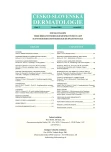-
Medical journals
- Career
Mastocytosis in Children
Authors: H. Bučková 1; J. Feit 2
Authors‘ workplace: Kožní oddělení Pediatrické kliniky FN Brno a LF MU v Brně 1; Ústav patologie FN Brno a LF MU v Brně 2
Published in: Čes-slov Derm, 85, 2010, No. 3, p. 129-138
Category: Reviews
Overview
Increased number of mastocytes in the skin and/or other tissues and organs is the typical feature of mastocytosis. In children, skin forms of mastocytosis prevail and, usually, heal without therapy. Systemic mastocytosis is rare in children. We discuss WHO classification of mastocytoses and screening protocol, which helps to establish the diagnosis and choose the appropriate therapy and follow-up of affected children.
Key words:
mastocytosis – etiopathogenesis – classification – examination protocol – therapy – differential diagnostics
Sources
1. Akin, C. Molecular diagnosis of mast cell disorders: a paper from the 2005 William Beaumont Hospital Symposium on Molecular patology. J Mol.Diagn, 2006;8: p. 412-419.
2. Aloe L, Levi-Montalcini, R. Mast cell increase in tissue of neonatal rast injected with nerve growth factor. Brain Res, 1977;133: p. 358-366.
3. Ben-Amitai, D., Metzker, A.,Cohen, HA. Pediatric cutaneous mastocytosis: a review of 180 patients Isr Med Assoc J, 2005; 7: p. 320-322.
4. Brockow, K., Akin,C., Hubert, M. et al. Assesment of the extent of cutaneous involement in children and adults with mastocytosis: relationship to symptomatology, tryptase levels, and bone marrow patology, J.Am Acad Dermatol, 2003; p. 508-516.
5. Bučková, H., Buček, J. Mastocytózy. Čes-slov Dermatol,1998;73 Supplementum,7-14.
6. Dvorak, AM. Human mast cell ultrastructural observation in situ, ex vivo and in vitro sites, sources, and systems.In: Kaliner MA,Metcalfe D.The mast cell in health and Disease. New York, Marcel Dekker 1992; p. 709-722.
7. Galli, SJ., et al. Reversible expansit of primate mast cell population in vivo by stem cell factor. J. Clin,Invest., 91, 1993, p. 148-152.
8. Hannafor,d., Rogers, M. Presentation of cutaneous mastocytosis in 173 children. Austral. J Dermatol, 2001; 42: p. 15-21.
9. Hartmann, K., Metcalfe, DD.: Pediatric mastocytosis. Hematol Oncol Clin North Am, 2000; 14: p. 625-640.
10. Hartmann, K., Henz, BM. Classification of cutaneous mastocytosis: a modified consensus propsal. Leuk Res, 2002; 26: p. 483-484.
11. Heide, R., Beishuizen, A., et al. Mastocytoses in Children: A Protocol For Management. Pediatric Dermatology, 2008;25, N4, p. 493-500.
12. Heide, R., deWaard-van der Spek, et al. Efficacy of 25% diluted fluticasone propionáte 0,05% creamas wet-wrap treatment in cutaneous mastocytosis. Dermatology, 2007; 214, p. 333-335.
13. Horny, HP., Sotlar, K., Valent, P. Mastocytosis: state of art. Pathobiology, 2007; 74: p. 121-132.
14. Kambe, N, Miyachi, Y.A: Possible mechanism of mast cell proliferation in mastocytosis. J Dermatol, 2002;29 (1): p. 1-9.
15. Kirshenbaum, AS., Goff, JP., Irani, A., et al. Interleukin 3 dependent growth of basofil –like cells and mast –like cells from human bone marrow in interphase cultures. J. Immunol, 1989; 142: p. 2424-9.
16. Kittamura, Y., Kasugai, T. et al. Development of mast cells and basophil process and regulation mechanisms. Am J Med Sci, 1993; 306: p. 185-191.
17. Longley, J., Duffy, TP. et al. The mast cell and mast cell dinase. J Amer Acad Dem, 1995; 32: p. 545-561.
18. Mc Kee, PH. Pathology of the skin. 3. vydání Mosby Wolf, London, 2001; p. 238-241.
19. Middelkamp, Hup MA(PD6), Heide, R., Tank, B., et al. Comparison of mastocytosis with onset in children and adults, J Eur Acad Dermatol Venereol, 2002;16: p. 115-120.
20. PALLER, A. S. HURWITZ. Clinical Pediatric Dermatology: a textbook of skin disorders of childhood and adolescence. Philadelphia: Elsevier Saunders, 2006. 3rd ed. 737 p. (225-229).
21. Pardani, A., Akin, C.,Valent, P. Pathogenesis, clinical features, and treatment advances in mastocytosis, Best Pract Res Clin Hematom, 2006; 19: p. 595-615.
22. Valent, P., Horny, HP.,Escribano,L. et al. Diagnostic criteria and classification of mastocytosis: a consensus proposal. Leuk Res, 2001;25: p. 603-625.
23. Valent, P. Diagnostic evaluation and classification of mastocytosis. Immunol.Allergy Clin North Am, 2006; 26: p. 515-534.
24. Van Gysel, D., Oranje, AP. Mastocytosis. In: Harper JI, Oranje AP, Prose NP,eds. Textbook of pediatric dermatology, 2nd edn, London: Blackwell Science, 2006, p. 703-713.
25. Verzijil, A., Heide, R., Oranje, AP. et al. C-kit Asp-816-Val station analysis in patients with mastocytosis. Dermatology, 2007; 214: p. 15-20.
26. Weidner, N., Austen, K.F., et al: Evidence of morfologic diversity of human mast cells: an ultrastructural study of mast cells from multiple body sites. Lab. invest, 63, 1990, p. 63-67.
27. WHO Classificationof Tumours of Haematopoietic and Lymphoid Tissues, 4th Edition, IARC, 2008.
28. Yanagihori, H. ,Oyama, N.,Nakanuta, K. et al. C-kit station in patients with childhood-onset mastocytosis and genotyp-phenotyp correlation, J Mol Dian, 2005; 7: p. 252-257.
Labels
Dermatology & STDs Paediatric dermatology & STDs
Article was published inCzech-Slovak Dermatology

2010 Issue 3-
All articles in this issue
- Mastocytosis in Children
- Phototherapy in the Czech Republic
- Association of HLA-DR and -DQ Alleles with Pemphigus Vulgaris in Slovak Population
- Intense Pulsed Light – Biological and Physical Effects
- Lymphogranuloma Venereum: in the Czech Republic Already?
- 90th Anniversary of the Foundation of the Department of Dermatology and Venereology in Brno and the Legacy of Antonín Trýb’s Personality
- Czech-Slovak Dermatology
- Journal archive
- Current issue
- Online only
- About the journal
Most read in this issue- Mastocytosis in Children
- Phototherapy in the Czech Republic
- Intense Pulsed Light – Biological and Physical Effects
- Lymphogranuloma Venereum: in the Czech Republic Already?
Login#ADS_BOTTOM_SCRIPTS#Forgotten passwordEnter the email address that you registered with. We will send you instructions on how to set a new password.
- Career
